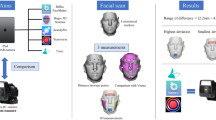Abstract
During the course of treatment in plastic surgery and dermatology, especially aesthetic surgery, it is essential to regularly observe and record any appearance changes of the body. Physicians typically use an interview, photographs of the patient’s face before and after treatment, and anatomical data including size, position, and color. However, it is difficult to photograph the affected area under the same conditions every time because the range of the photograph varies depending on the angle and distance. In addition, measurements with a measuring tape are similarly difficult to reproduce. In this study, we used an infrared depth sensor and RGB sensor built into a smartphone to measure the shape of the face and the color of the skin in three dimensions. The face shape and color were measured before and after modulation, and the changes in volume and skin pigmentation of the skin color were calculated and visualized. It was then possible to analyze the shape and skin tone independent of the viewing angle and direction of illumination light. This research shows the possibility of monitoring changes in facial shape and skin tone with a depth camera built into a smartphone. This technology is expected to contribute to the development of telemedicine, where patients can measure their faces at home and receive treatment consultations remotely.










Similar content being viewed by others
References
Krowchuk DP et al (2019) Clinical practice guideline for the management of infantile hemangiomas. Pediatrics 143.1:e20183475
Canfield Scientific, Inc. (2020) VECTRA H1 3D imaging system. https://www.canfieldsci.com/imaging-systems/vectra-h1-3d-imaging-system/. Accessed 27 Mar 2020
Camison L et al (2018) Validation of the Vectra H1 portable three dimensional photogrammetry system for facial imaging. Int J Oral Maxillofac Surg 47(3):403–410
Seitz SM et al (2006) A comparison and evaluation of multi-view stereo reconstruction algorithms. In: 2006 IEEE computer society conference on computer vision and pattern recognition (CVPR’06), vol 1, IEEE
Masui K, Kiyomitsu K, Ogawa-Ochiai K et al (2020) Technology for visualizing the local change in shape of edema using a depth camera. Artif Life Robot. https://doi.org/10.1007/s10015-019-00541-1
Apple Inc. (2020) iPhone. https://www.apple.com/iphone/. Accessed 27 Mar 2020
Bellus3D Inc. (2020) Bellus 3D:High-quality 3D face scanning. https://www.bellus3d.com/. Accessed 27 Mar 2020
Besl PJ, Neil DM (1992) Method for registration of 3-D shapes. Sensor fusion IV: control paradigms and data structures. Int Soc Opt Photon 1611:5
Fischler MA, Bolles RC (1981) Random sample consensus: a paradigm for model fitting with applications to image analysis and automated cartography. Commun ACM 24(6):381–395
Moller T, Trumbore B (1997) Fast, minimum storage ray—triangle intersection. J Graph Tools 21:21–28
Mukaida S et al (2002) Facial image synthesis system: FUTON evaluation as tools for cognitive research on face processing. Trans IEICE 85(10):1126–1137
Tsumura N et al (2003) Image-based skin color and texture analysis/synthesis by extracting hemoglobin and melanin information in the skin. ACM Trans Graph (TOG) 22(3):770–779
Acknowledgements
We thank Ashleigh Cooper, Phd, from Edanz (https://jp.edanz.com/ac) for editing a draft of this manuscript.
Author information
Authors and Affiliations
Corresponding author
Additional information
Publisher's Note
Springer Nature remains neutral with regard to jurisdictional claims in published maps and institutional affiliations.
About this article
Cite this article
Koike, R., Nomura, I., Ogawa-Ochiai, K. et al. Creating a visualization system for changes in facial shape and color. Artif Life Robotics 27, 29–37 (2022). https://doi.org/10.1007/s10015-022-00733-2
Received:
Accepted:
Published:
Issue Date:
DOI: https://doi.org/10.1007/s10015-022-00733-2




